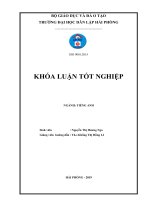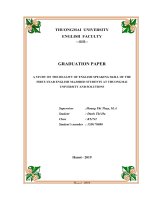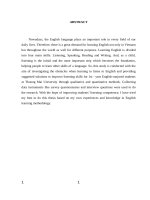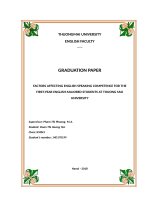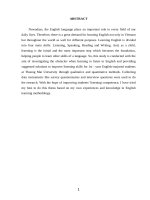Difficulties in listening skills of english majored freshmen at thuong mai university and some suggested solutions
Bạn đang xem bản rút gọn của tài liệu. Xem và tải ngay bản đầy đủ của tài liệu tại đây (314.22 KB, 62 trang )
ABSTRACT
Nowadays, the English language plays an important role in every field of our
daily lives. Therefore, there is a great demand for learning English not only in Vietnam
but throughout the world as well for different purposes. Learning English is divided
into four main skills: Listening, Speaking, Reading and Writing. And, as a child,
listening is the initial and the most important step which becomes the foundation,
helping people to learn other skills of a language. So, this study is conducted with the
aim of investigating the obstacles when learning to listen to English and providing
suggested solutions to improve listening skills for 1st - year English-majored students
at Thuong Mai University through qualitative and quantitative methods. Collecting
data instruments like survey questionnaires and interview questions were used to do
the research. With the hope of improving students’ listening competence, I have tried
my best to do this thesis based on my own experiences and knowledge in English
learning methodology.
1
1
ACKNOWLEDGEMENTS
During the process of doing this graduation paper, I have received a lot of
essential assistance, precious ideas and timely encouragements from my teacher,
family and friends.
First of all, I would like to express my deepest gratitude to my supervisor, Ms.
Nguyen Thi Thanh Ha who has always been willing to give me valuable support,
guidance, and encouragement in order that I can complete successfully this study.
I also would like to take this opportunity to convey my sincere thanks to all my
teachers in the English faculty, Thuong Mai University, who have taught me basic
knowledge for four years to complete this study. My grateful appreciation goes to 52
students of K54 at the Faculty of English, TMU for their enthusiastic help and support.
Lastly, special thanks and love to my family and friends who were always by my
side and gave me motivation in my education and every other aspect of life.
2
2
Student
Hoang Thi Ngan
TABLE OF CONTENTS
3
3
4
4
LIST OF TABLES AND CHARTS
TABLES
Table 3.1. Student’s learning English background
Table 3.2. Attitude of students towards English listening lessons
CHARTS
Chart 3.1.Students’ English listening level
Chart 3.2. Students assessment about the level of difficulty of
English listening
Chart 3.3. Students’ assessment of their weakest English skill
Chart 3.4. Students’ opinion about the importance of English
listening skill
Chart 3.5. Students’ frequency in practicing listening to English
Chart 3.6. Some kinds of material students use to listen
Chart 3.7. What students do during listening
Chart 3.8. What students do before listening
Chart 3.9. Difficulties which students face in listening
LIST OF ABBREVIATIONS
Acronym
5
Meaning
5
TMU
6
Thuong Mai University
6
7
7
CHAPTER 1: OVERVIEW OF THE STUDY
1.1. Rationale
In recent years, Vietnam's economy has been integrating more deeply and
broadly with the global economy. The demand for high - quality resources has not
only deepened but also for proficiency in foreign languages and soft skills.
Nowadays, English has become an important part of every business. It is the key to
opening the door to discover and exploit new markets, and seek foreign investors
and production scale. English is considered the second-most widely used language
throughout the world. There are four skills in English communication: listening,
speaking, reading, and writing. Of the four language skills, listening is believed to
be the most challenging for the students.
As a researcher, I would like to present the thesis titled “Difficulties in
Listening Skills of English-majored Freshmen at Thuong Mai University and some
suggested solutions” for several reasons.
First of all, listening is the initial and most important skill in communication.
In reality, in the process of learning a language, human beings have to listen
correctly, which results in speaking or reading correctly. Besides, people can
understand each other thanks to communication. Communication is simply the act
of transferring information from one person to another. The way they understand
others is through their languages. No matter what the language is, as long as they
understand each other, it means they have already completed the process of
communication. Of the four language skills, listening and speaking are two major
parts of communication. They are closely interdependent. If we cannot hear, of
course, we cannot speak. If we fail to understand spoken language, we may miss
important information and cannot respond or respond in an inappropriate way.
8
Secondly, listening is viewed as the most difficult skill in learning a language.
Unlike reading, a reader could base on the text and could have opportunities to refer
back to read the text over and over again; besides, a reader can control the speed of
reading and has more time to get its meanings; whereas, a listener has to understand
the messages without any text and just one time.
Last but not least, the ability of listening requires long and extremely hard
effort to progress. That is the reason why a lot of people feel bored and easily give
up learning to listen.
Like many other universities, many students at Thuong Mai University,
especially 1st - year students of English Faculty, are faced with many difficulties
when they listen. Listening skills not only help many students widen their
knowledge but also advance them to improve other language skills such as speaking
and writing. That motivates them to find effective listening methods that help them
to improve their listening skill.
That is why the writer decided to choose the study.
1.2. Previous Studies
When researching this topic, the researcher explored some previous studies of
other researchers.
In “A study of English listening problems and listening proficiency of business
students at Bangkok university” by Asst. Prof. Watjana Suriyatham, Questionnaires,
IELTS Tests and Interviews were used to investigate the main reason that caused
listening problems for students is the listening text. Besides, the lack of practicing
the listening skill and lack of exposure to different kinds of listening materials are
also considerable causes. More importantly, the findings of this study helped the
teachers to recognize students’ listening problems. In this study, the author mainly
brings out some solutions for teaching effectively. My study presents solutions for
9
learning English listening skills instead.
Another study titled “The Difficulties encountered by EFL Learners in
Listening Comprehension as perceived by ELC Students at the Arab American
University-Jenin” by Ahkam Hasan Assaf. The study aimed to investigate the
difficulties EFL students encounter in listening comprehension as perceived by ELC
students at the AAUJ through two different data collection instruments: a survey
questionnaire and two interview questions. The results of the study showed that
there were no significant differences in the difficulties students encountered in
listening comprehension due to academic level, academic year, gender, type of
school and number of school years studying English. In this study, the author paid
attention to difficulties more, he did not present effective methods helping students
to learn listening fruitfully.
The last study which I found is “The difficulties in Learning Listening Skill of
Non-English Major Learners at the University of Industry and how to deal with
these difficulties” by an anonymous Industry student. The author discovered some
obstacles and solutions to improve listening skill but they are somewhat meagre and
generalized.
Therefore, I would like to present a few more factors which affect listening
and more concrete recommendations and suggestions.
1.3. Aims of the Study
This study was conducted in order to explore the current situation of English
listening skill of 1st - year students of the English Faculty at Thuong Mai University.
More specifically, this study attempts to investigate the difficulties that the students
faced when learning listening English and the factors bringing about difficulties for
the 1st year students of English major. Based on the findings, the research further
seeks to suggested solutions to help the students overcome the difficulties in order
to improve their listening effectively.
10
1.4. Research Subjects
The subjects of this study are difficulties in Listening Skills of the English-majored
Freshmen at Thuong Mai University and some suggested solutions. The participants
are 52 K54 students in English faculty at Thuong Mai University. The participants
consisted of 48 female and 4 male students who are learning English in business.
They came from different provinces and they were divided into different classes to
study every subject together. This practice formed multi-level classes. In English
classes, while some students were good at English, others had lower English
proficiency.
1.5. Scope of the Study
The research has been completed to find out the reality of learning the
listening skill in the first-year students of the English Department and provide some
techniques to help them improve their English listening skill. It was carried out over
one month in the second semester of the 2018-2019 academic year. However, the
study could not include all K54 students at Thuong Mai University, its scope are
only 52 students of K54 at English Faculty. Thus, the results of the study are limited
to the students enrolled in this study and the findings can affect the generalization of
the larger population of all students. It can also be a reference for anyone who wants
to practice listening to English.
1.6. Research Methodology
In consideration of the research’s purposes, this study was completed in both
quantitative and qualitative. The data was collected by means of survey
questionnaires and interview questions at Thuong Mai University.
The main method of the study was a quantitative survey questionnaire.
Furthermore, in order to achieve the set goals, the researcher collected some
information based on her interviews qualitative method to make sure that the data
11
would be more accurate and reliable.
A combination of two different methods above will provide reliable data,
based on which the conclusions and suggestions will be made in the following parts.
The quantitative data were presented in the form of tables while the qualitative data
collected from open-ended questionnaires and interviews were presented by quoting
relevant responses. Then the data were analyzed both descriptively and
interpretively.
The purpose of using questionnaires and interviews as research materials to
collect data in this study is to triangulate the data and to overcome the limitations or
drawbacks of other methods because one can well support another which helps
strengthen the research findings.
Both survey questionnaire and interview questions were used to serve the
focal questions that guide the study. These focal questions are:
1) What are the difficulties which in learning English listening skill of
English-majored freshmen at Thuong Mai university?
2) What are strategies which help them to improve their English listening
skill?
1.7. Organization of the Study
The study is divided into 4 main chapters:
Chapter 1: OVERVIEW OF THE STUDY includes the rationale, the aim of
the study, research questions, the scope, the significance, the research methodology
and the organization of the study.
Chapter 2: LITERATURE REVIEW gives situation analysis, research
12
question, the methods of the study. This chapter studies on data collection, data
analysis and provides the definition of listening, the significance of listening, the
processes of listening comprehension and factors affecting student’s listening skill.
Chapter 3: RESEARCH FINDINGS studies on findings, discussions of
findings and some recommendations for TMU students
Chapter 4: RECOMMENDATIONS AND SUGGESTIONS gives a summary,
limitations of the study and suggestions for further research.
CONCLUSION
13
CHAPTER 2: LITERATURE REVIEW
2.1. Overview of Listening
The purpose of this chapter is to review the theories concerning the subject
matter of the study. The literature review consists of four sections: section one
resolves definitions of listening, section two focuses on types of listening, section
three deals with the significance of listening and the last section is about processes
of listening comprehension.
2.1.1. Definition of listening skill
There are many definitions of listening in language learning methodology.
Listening is defined as the ability to recall and understand information which is
presented orally. Listening is not only important but it is also difficult, becoming the
problem of many people who learn languages. That is the reason why more and
more people pay attention to this skill. So far, there have been a number of
definitions of listening by different linguists.
According to Thomlison’s (1984) listening is “the ability to identify and
understand what others are saying. This process involves understanding a speaker’s
accent and pronunciation, the speaker’s grammar and vocabulary, and
comprehension of the meaning. An able listener is capable of doing these four
things simultaneously”.
Ronald and Roskelly (1985) stated that “listening is an active process
requiring the same skills of prediction, hypothesizing, checking, revising, and
generalizing that writing and reading demand.
Hirsch (1986) defined “listening as an aspect of skills: involves neurological
14
response and interpretations of sounds to understand and to give meaning by
reacting, selecting meaning, remembering, attending, analyzing and including
previous experience”.
Purdy (1997) defined listening as “the active and dynamic process of
attending, perceiving, interpreting, remembering, and responding to the expressed
(verbal and non-verbal), needs, concerns, and information offered by other human
beings”. Therefore, in order to listen well, listeners have to use a variety of
strategies and tips to make sense, not hearing only.
According to Brown (2001), listening is “not merely the process of
unidirectional receiving of audible symbols”. He supposed that one aspect of
listening comprehension which is “the psychomotor process of receiving sound
waves through the ear and transmitting nerve impulses to the brain”. Hence,
listening comprises of three elements: the sender, the message and the listener.
Ma Lihua (2002), stated that listening is “a complex psychological process of
listeners’ understand language by the sense of hearing. It is an interactive process of
language knowledge and psychological activities. However, this process is not
simply decoding the message, it also involves the combining of the decoding or the
message process with its reconstruction as meaning”.
O’Malley, Chamot, and Kupper (1989) stated that “listening comprehension is
an active and conscious process in which the listener constructs meaning by using
cues from contextual information and from existing knowledge while relying upon
multiple strategic resources to fulfil the task requirement”.
In short, to listen effectively, people must be actively involved in the
communication process, and not just listening passively.
2.1.2. Types of Listening
Most people, most of the time, take listening to a language for granted, unlike
15
other skills, it is something that just happens. It is only when you stop to think about
listening and what it entails that you begin to realize that listening is, in fact, an
important skill that needs to be nurtured and developed in a long process with a lot
of effort.
Effective listening is the foundation that underpins all positive human
relationships. If there are a lot of different definitions of listening skill, there are
many different opinions about its clarification. This part draws on the work of
Wolvin and Coakely (1996) and others to demonstrate the various types of listening
2.1.2.1. General Listening Types
. The two main types of listening – the foundations of all listening subtypes
are:
- Discriminative Listening
- Comprehensive Listening
•
Discriminative Listening
Discriminative listening is first developed at a very early age – perhaps even
before birth, in the womb. This is the most basic form of listening and does not
involve the understanding of the meaning of words or phrases but merely the
different sounds that are produced. In early childhood, for example, a distinction is
made between the sounds of the voices of the parents – the voice of the father
sounds different from that of the mother.
Discriminative listening develops through childhood and into adulthood. As
we grow older and develop and gain more life experience, our ability to distinguish
between different sounds is improved. Not only can we recognize different voices,
but we also develop the ability to recognize subtle differences in the way that
sounds are made – this is fundamental to ultimately understanding what these
16
sounds mean. Differences include may subtleties, recognizing foreign languages,
distinguishing between regional accents and clues to the emotions and feelings of
the speaker.
Being able to distinguish the subtleties of sound made by somebody who is
happy or sad, angry or stressed, for example, ultimately adds value to what is
actually being said and, of course, does aid comprehension. When discriminative
listening skills are combined with visual stimuli, the resulting ability to listen to
body-language enables us to begin to understand the speaker more fully – for
example recognising somebody is sad despite what they are saying or how they are
saying it.
• Comprehensive Listening
Comprehensive listening involves understanding the message or messages that
are being communicated. Like discriminative listening, comprehensive listening is
fundamental to all listening sub-types.
In order to be able to use comprehensive listening and therefore gain
understanding the listener first needs appropriate vocabulary and language skills.
Using overly complicated language or technical jargon, therefore, can be a barrier to
comprehensive listening. Comprehensive listening is the further complicated by the
fact that two different people listening to the same thing may understand the
message in two different ways. This problem can be multiplied in a group setting,
like a classroom or business meeting where numerous different meanings can be
derived from what has been said.
Comprehensive listening is complimented by sub-messages from non-verbal
communication, such as the tone of voice, gestures and other body languages. These
non-verbal signals can greatly aid communication and comprehension but can also
confuse and potentially lead to misunderstanding. In many listening situations, it is
vital to seek clarification and use skills such as reflection aid comprehension.
17
2.1.2.2. Specific listening types
Listening types can be defined by the goal of listening. The three main types
of listening most common in interpersonal communication are:
- Informational Listening (Listening to learn)
- Critical Listening (Listening to Evaluate and Analyze)
- Therapeutic or Empathetic Listening (Listening to understand Feeling and
Emotion).
• Informational Listening
Whenever you listen to learn something, you are engaged in informational
listening. This is true in many day-to-day situations, in education and at work. It is
also true when you listen to the news, watch a documentary, when a friend tells you
a recipe or when you are talked-through a technical problem with a computer –
there are many other examples of informational listening too.
Although all types of listening are ‘active’ – they require concentration and a
conscious effort to understand. Informational listening is less active than many of
the other types of listening. When we are listening to learn or be instructed we are
taking in new information and facts, we are not criticizing or analyzing.
Informational listening, especially in formal settings like in work meetings or while
in education, is often accompanied by note taking – a way of recording key
information so that it can be reviewed later.
• Critical Listening
We can be said to be engaged in critical listening when the goal is to evaluate
or scrutinize what is being said. Critical listening is a much more active behavior
than informational listening and usually involves some sort of problems solving or
18
decision making. Critical listening is akin to critical reading; both involve analysis
of the information being received and alignment with what we already know or
believe. Whereas informational listening may be mostly concerned with receiving
facts and/or new information – critical listening is about analysing opinion and
making a judgement.
When the word ‘critical’ is used to describe listening, reading or thinking it
does not necessarily mean that you are claiming that the information you are
listening is somehow faulty or flawed. Rather, critical listening means engaging in
what you are listening to by asking yourself questions such as, ‘what is the speaker
trying to say?’ or ‘what is the main argument being presented?’, ‘how does what I
am hearing differ from my beliefs, knowledge or opinion?’. Critical listening is,
therefore, fundamental to true listening.
Many day-to-day decisions that we make are based on some forms of ‘critical’
analysis, whether it be critical listening, reading or thought. Our opinions, values
and beliefs are based on our ability to process information and formulate our own
feelings about the world around us as well as weigh up the pros and cons to make
an informed decision.
It is often important when listening critically, to have an open-mind and not be
biased by stereotypes or preconceived ideas. By doing this you will become a better
listener and broaden your knowledge and perception of other people and your
relationships.
• Therapeutic or Empathic Listening
Empathic listening involves attempting to understand the feelings and
emotions of the speaker – to put yourself into the speaker’s shoes and share their
thoughts.
Empathy is a way of deeply connecting with another person and therapeutic or
19
empathic listening can be particularly challenging. Empathy is not the same as
sympathy, it involves more than being compassionate or feeling sorry for somebody
else – it involves a deeper connection – a realisation and understanding of another
person’s point of view.
Counsellors, therapists and some other professional use therapeutic or
empathic listening to understand and ultimately help their clients. This type of
listening does not involve making judgement or offering advice but gently
encouraging the speaker to explain and elaborate on their feelings and emotions.
Skills such as clarification and reflection are often used to help avoid
misunderstandings.
We are all capable of empathic listening and may practice it with friends,
family and colleagues. Showing empathy is a desirable trait in many interpersonal
relationships – you may well feel more comfortable talking about your own feelings
and emotions with a particular person. They are likely to be better at listening
empathetically to you than others, this is often based on similar perspectives,
experiences, beliefs and values – a good friend, your spouse or sibling for example.
2.1.3. Significance of Listening
No one can deny the importance of listening skills in foreign language
learning because the key to acquire a language is to receive language input.
Listening is the first language mode that provides the foundation of cognitive
development and the most common communicative activity in daily live. Morley
(1991) stated that listening is the thing that people do most of their time. ‘We have
two ears but only one mouth’, that is the reason why people listen more than they
speak, read and write. Moreover, Gilakjana and Ahmadi (2011) stated that of the
total time spent on communicating, listening takes up 40-50%; speaking accounts
for 25-30%; reading and writing, about 9%, which means that listening is crucial for
communication.
20
To understand more deeply about the importance of listening, it is necessary to
distinguish between ‘listening’ and ‘hearing’. Hearing is an accidental and
automatic brain response to sound that requires no effort. We are surrounded by
sounds most of the time. There are a lot of kinds of sounds which people can hear
every day such as the sounds of bicycles, airplains, lawn mowers, and so on. People
usually ignore them. Listening, on the other hand, is purposeful and focused rather
than accidental. Therefore, it requires motivation and effort. Hearing is a part of five
senses (hearing, smelling, tasting, touching and looking) and a part of listening as
well. If hearing is through ears, then listening is through mind. The purpose of
listening is understanding the meanings expressed by a speaker. Hence, listening is
essential not only as a receptive skill but also to the development of spoken
language proficiency.
According to Devine (1982), listening is the primary means by which
incoming ideas and information are taken in. In fact, students from kindergarten to
high school were expected to listen to 65-90 per cent of the time. This is easily
demonstrated at schools in Vietnam, where the main activity of students in class is
listening to teachers. Wolvin and Coakley (1988) concluded that, both in and out of
the classroom, listening consumes more of daily communication time than other
forms of verbal communication. Listening is central to the lives of students
throughout all levels of educational development (Coakley & Wolvin, 1997).
Listening is the most frequently used language skill in the classroom (Ferris, 1998;
Murphy, 1991; Vogely, 1998). Both instructors (Ferris & Tagg, 1996) and students
(Ferris, 1998) acknowledge the importance of listening comprehension for success
in academic settings. Numerous studies indicated that efficient listening skills were
more important than reading skills as a factor contributing to academic success
(Coakley & Wolvin, 1997).
As for students of the English Department, TMU, especially English-majored
freshmen, the importance of listening skill is undeniable. Because most of the
specialized subjects at school are taught in English, it is very difficult for students to
21
understands the lesson if they cannot listen. Besides, when it comes to four skills in
learning a language, people can easily list them respectively: listening, speaking,
reading, and writing. However, not everyone understand that it is also the orderly
process for a language learner. Listening is the first step and well listening is the
solid foundation for developing other skills.
2.1.4. Processes of listening comprehension
As mentioned above, listening is the psychological process of receiving,
attending to, constructing meaning from, and responding to spoken or nonverbal
messages. There are four steps in the listening process.
The first step is receiving. It refers to the response caused by sound waves
stimulating the sensory receptors of the ear; it is the physical response.
The next step is understanding. It is the stage at which you learn what the
speaker means - the thoughts and emotional tone.
The third step is remembering. It is an important listening process because it means
that an individual has not only received and interpreted a message but has also added it to
the mind’s storage bank. However, just as our attention is selective, so too is our memory
– what is remembered may be quite different from what was originally seen or heard.
The final step is evaluating. It consists of judging the messages in some way.
At times, you may try to evaluate the speaker’s underlying intentions or motives.
Often this evaluation process goes on without much conscious awareness.
It can be concluded that listening is a complex process. When you have ears,
you can hear everything within hearing range; but that does not necessarily mean
you understand what you heard. Listening, on the other hand, is a skill.
2.2. Factors affecting students’ English listening
22
2.2.1. Lack of motivation
Motivation is an important term in language learning and it is multidimensional.
Motivation is a process. It's not a goal, like a product. On the contrary, it is a tool
that helps us achieve our goals. At first, we feel interested and set goals and decide
to take appropriate action. Then, we try to maintain our interest and struggle to fulfil
our purpose. This process plays a big role especially in learning the language as it
makes language learning more meaningful. Slavin (1997, 345) describes this
process in the general sense: "... motivation is what helps you go, helps you go and
determines where you are trying to go". As it is evident, motivation provides
students with a direction to follow. It is a concept that reveals why people act and
think like they do (Weiner 1992 in Wlodkowski (1999).
These aspects of motivation are supported by Brophy's method for motivation
(1998, 3): "Motivation is a theoretical construct used to explain the beginning,
direction, intensity, and motivation. Maintenance of behaviour, especially behaviour
towards the goal. In the classroom context, the concept of student motivation is
used to explain the degree to which students invest in attention and effort in
different activities, which may or may not be something that the teacher desire ". As
it is evident, motivation constitutes one of the significant backbones of the learning
process in student life; So many studies put a high value on this concept.
Lack of motivation is still a big problem for both teachers and students in
language classes. It is important to identify the cause of insufficient motivation and
know how to deal with students who lack motivation. Timmins (1999) suggests finding
reasons for lack of motivation in students by using psychology in the classroom.
Therefore, it is very important for the teacher to put emotional factors into account.
Any threat to the psychology of students also reduces their interest in the
lesson. However, it is not a problem that cannot be solved. Teachers should take a
23
more careful role. McDonough (2007, 2) describes the role of the teacher in this
regard: "Linking provides a supportive and challenging learning environment, but
also facilitates the development of motivational thinking of the learner, in addition
to determining their original orientation. “Similarly, the willingness to transfer roles
between teachers and students is motivating to learn, so positive emotions are in
fact students taking on a more active role in learning. Scharle and Szabo (2005, 7)
said, "a sense of responsibility and independence brings feelings of happiness and
confidence." In classrooms, where students give students the opportunity to get
active participants, students become more eager for the unit. Therefore, learner
autonomy motivates their level of motivation to learn. Self-help environments
provide students with choice and encouragement.
Motivation is essential in doing everything, including in learning something.
In learning language, learners need motivation because it helps them in trying and
develop their understanding of a new language. With motivation, a learner wants to
succeed. So without it, he or she certainly would not make the necessary effort. In
addition, Harmer (2003: 10) outlines some of the characteristics of good learners in
the classroom, including the willingness to listen, readiness to read, willingness to
ask questions, willingness to think about learning and available will accept the
adjustment.
So, it is part of a teacher’s job to encourage students and create a good
atmosphere for them to study.
2.2.2. Quality of Recorded Materials
Not only listening English, but any kinds of sound arround us, the quality of
sound system is the important factor which decides listening results. If the sound is
squeaky, or simply too small, of course the listener cannot listen well. Therefore, in
classrooms, ensuring that the recorded materials have appropriate volume which
everyone can hear is essential.
24
2.2.3. Pronunciation
Pronunciation is the most essential thing we have to master. Otherwise, we
cannot get the message that people say. According to Penny Ur (2001), Jack C.
Richard (2002), pronunciation is the sound of language or phonology; tension and
rhythm; and intonation and can insert each sound and segment and ultrasound. In
addition, Otłowski (2004: 1) states that pronunciation is an acceptable or common
practice. From above, we can conclude that an interpreter is a sound generator that
is divided and that segments are accepted or understood.
Learners who have good English pronunciation can be understood even if they
have errors in other areas, while poorly learned ones will not understand, even if
their grammar is perfect. Pronunciation is one of the most important things that
students must master to communicate fluently. According to Fangzhi (1998: 39), it
is important to pay attention to the pronunciation as it results in the message that
one can be passed on or not by others. This leads to the fact that only when we
pronounce correctly, can we speak and listen correctly. In addition, Gilbert (quoted
in Otlowsky, 2004: 3) stated that if someone could not hear English well, she or he
would be ignored. We can conclude from above that pronunciation has a significant
effect on the meaning of what others say and hear as well.
2.2.4. Vocabulary
Vocabulary is an important element which needs for teaching and learning a
foreign language. It is the foundation for the development of all other skills: reading
comprehension, listening comprehension, speaking, and writing. Vocabulary is a
key tool for students in their efforts to use effective English. When facing a native
English speaker, when watching a movie without subtitles or when listening to a
favorite English song, when reading a text or writing a letter to a friend, the student
will always need to use vocabularies.
The fact is that students often find it difficult to listen to English well. Their
25

